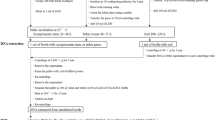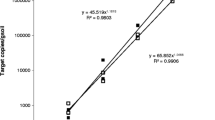Abstract
Specific PCR primers were developed for identifying two post harvest pathogens, Mycocentrospora acerina and Fibularhizoctonia carotae, which cause liquorice rot and crater rot respectively, during prolonged low temperature storage of carrots. The methods allow routine detection of less than 0.3 pg of M. acerina DNA and less than 0.03 pg F. carotae DNA, even in the presence of large excess of plant or soil DNA. Standard PCR and quantitative PCR gave similar results and either method could be used in a practical situation. Experiments were carried out testing these methods on different types of carrot tissue- and soil- samples. Soil was sampled before sowing, and soil adhering to the roots or root tissue was sampled at different times during the growing season or at harvest. Soil adhering to the carrots at harvest had the best predictive ability for liquorice rot development during storage (R2 predicted 74.9% using standard PCR), but samples taken during the growing season also gave reasonably good predictive ability values. PCR data from soil samples taken in the spring were not as good as a predictor for this disease. A dense sampling strategy using 20 m between sampling points generally gave better correlation between PCR data and disease data than using 40 m between the sampling points. Use of the developed methods in an IPM strategy for liquorice rot is discussed. For crater rot the correlation between PCR data and disease data was generally poor for all types of samples. These results are discussed in relation to the biology of F. carotae.






Similar content being viewed by others
References
Adams, G. C., & Kropp, B. R. (1996). Athelia arachnoidea, the sexual stage of Rhizoctonia carotae, a pathogen of carrot in cold storage. Mycologia, 88, 459–472.
Barnett, H. L., & Hunter, B. B. (1998). Illustrated genera of imperfect fungi. St. Paul: The American Phytopathological Society.
Bonants, P., deWeerdt, M. H., van Gent Pelzer, M., Lacourt, I., Cooke, D., & Duncan, J. (1997). Detection and identification of Phytophthora fragariae Hickman by the polymerase chain reaction. European Journal of Plant Pathology, 103, 345–355.
Brierley, J. L., Stewart, J. A., & Lees, A. K. (2009). Quantifying potato pathogen DNA in soil. Applied Soil Ecology, 41, 234–238.
Davies, W. P., Lewis, B. G., & Day, J. R. (1981). Observations on infection of stored carrot roots by Mycocentrospora acerina. Transactions of the British Mycological Society, 77, 139–151.
Davis, R. M., & Raid, R. N. (Eds.). (2002). Compendium of umbelliferous crops diseases. St. Paul: The American Phytopathological Society.
Ellis, M. B. (1971). Dematiaceous hyphomycetes. Surrey: Commonwealth Mycologial Institute.
Erwin, D. C., & Ribiero, O. K. (1996). Phytophthora diseases worldwide. St. Paul: The American Phytopathological Society.
Evenhuis, A., Verdam, B., & Zadoks, J. C. (1997). Splash dispersal of conidia of Mycocentrospora acerina in the field. Plant Pathology, 46, 459–469.
Halstensen, A. S., Nordby, K.-C., Eduard, W., & Klemsdal, S. S. (2006). Real-time PCR detection of toxigenic Fusarium in airborne grain dust and associations with trichothecene mycotoxins. Journal of Environmental Monitoring, 8, 1235–1241.
Hermansen, A. (1992). Weeds as hosts of Mycocentrospora acerina. Annals of Applied Biology, 121, 679–686.
Hermansen, A., & Amundsen, T. (1995). Two methods for the prediction of Mycocentrospora acerina infection on stored carrots. Annals of Applied Biology, 126, 217–233.
Hermansen, A., & Amundsen, T. (2000). Records of airborne Mycocentrospora acerina conidia in and near carrot plots. Acta Agriculturae Scandinavica, Section B, Soil and Plant Science, 49, 258–264.
Hermansen, A., Amundsen, T., Taksdal, G., Dragland, S., Synnevåg, G., Flønes, M., et al. (2000). Variations in infection of Mycocentrospora acerina in carrot monoculture plots at four sites during 1985–95. Acta Agriculturae Scandinavica, Section B, Soil and Plant Science, 49, 248–257.
Hoftun, H. (1985). Testing of storage ability in carrots. Meldinger fra Norges landbrukshøgskole, 64(1), 1–11.
Lees, A. K., Brierley, J. L., Stewart, J. A., Hilton, A. J., Wale, S. J., Gladders, P., et al. (2010). Relative importance of seed-tuber and soilborne inoculum in causing black dot disease of potato. Plant Pathology, 59, 693–702.
Montgomery, D. C., Peck, E. A., & Vining, G. G. (2006). Introduction to linear regression analysis (4th ed.). New York: Wiley.
Ophel-Keller, K., McKay, A., Hartley, D. H., & Curran, J. (2008). Development of a routine DNA-based testing service for soilborne diseases in Australia. Australasian Plant Pathology, 37, 243–253.
Peters, J. C., Woodhall, J. W., Brierley, J. L., Wale, S. J., & Lees, A. K. (2011). Spatial distribution of soil-borne pathogens to inform disease risk prediction. Potato Research, 54, 94–95.
Rader, W. E. (1948). Rhizoctonia carotae n.sp. and Gliocladium aureum n.sp., two new root pathogens of carrots in cold storage. Phytopathology, 38, 440–452.
Sambrook, J., & Russell, D. W. (1989). Molecular cloning: a laboratory manual. New York: Cold Spring Harbor Laboratory Press.
Sutton, B. C., & Gibson, I. A. S. (1977). Mycocentrospora acerina. CMI Descriptions of pathogenic fungi and bacteria No. 537
Tooley, P. W., Bunyard, B. A., Carras, M. M., & Hatziloukas, E. (1997). Development of PCR primers from internal transcribed spacer region 2 for detection of Phytophthora species infecting potatoes. Applied and Environmental Microbiology, 63, 1467–1475.
Van der Plaats-Niterik, A. J. (1981). Monograph of the genus Pythium. Studies in Mycology. Baarn: Centraalbureau voor Schimmelcultures.
Wall, C. J., & Lewis, B. G. (1980). Survival of chlamydospores and subsequent development of Mycocentrospora acerina in soil. Transactions of the British Mycological Society, 75, 207–211.
White, T. J., Bruns, T., Lee, S., & Taylor, J. (1990). Amplification and direct sequencing of fungal ribosomal RNA genes for phylogenetics. In M. A. Innis, D. H. Gelfand, J. J. Sninsky, & T. J. White (Eds.), PCR Protocols. A guide to methods and applications (pp. 315–322). New York: Academic.
Acknowledgments
We thank Ann-Helen Kalhovd, Elisa Gauslå, Camilla Sekse, Hege Særvold Steen, Abdelhameed Elameen and Grete Lund for excellent and cheerful technical assistance. We also want to thank the Norwegian Agricultural Extension Service for taking part in sampling and disease assessment. This work was supported by The Norwegian Ministry of Agriculture and Food, the Research Council of Norway, Innovation Norway and Norwegian carrot growers.
Author information
Authors and Affiliations
Corresponding author
Rights and permissions
About this article
Cite this article
Hermansen, A., Wanner, L., Nærstad, R. et al. Detection and prediction of post harvest carrot diseases. Eur J Plant Pathol 133, 211–228 (2012). https://doi.org/10.1007/s10658-011-9896-x
Accepted:
Published:
Issue Date:
DOI: https://doi.org/10.1007/s10658-011-9896-x




